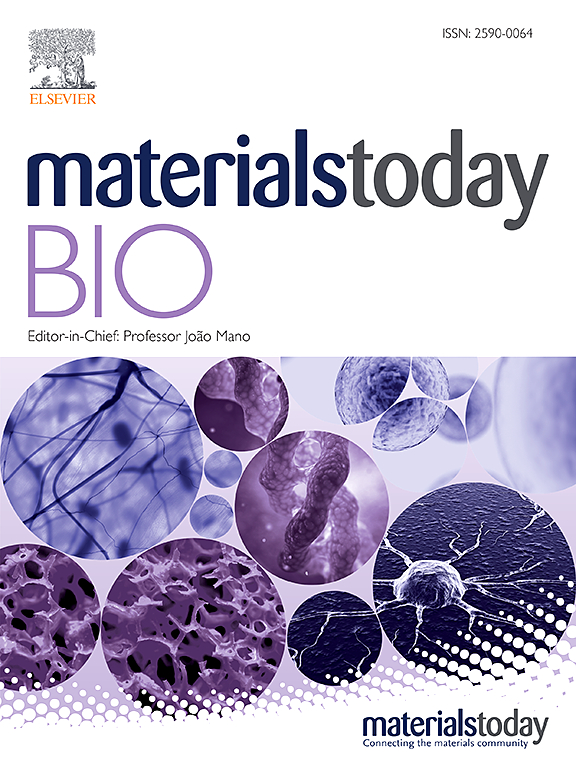A microfluidic electrochemical immunosensor for detection of CEA and Ki67 in 3D tumor spheroids
IF 8.7
1区 医学
Q1 ENGINEERING, BIOMEDICAL
引用次数: 0
Abstract
Microfluidic chip-based electrochemical sensors have been developed to detect cancer biomarkers and monitor changes in the tumor microenvironment. However, the limitation of detecting only a single biomarker restricts their utility as accurate diagnostic tools. Simultaneous detection of multiple tumor biomarkers is important for early diagnosis of cancer. In this work, we report the development of a microfluidic-based electrochemical immunosensor platform capable of simultaneously observing multiple biomarkers expressed by three dimensions (3D) cell spheroids. The sensor platform employs a nanocomposite electrode material consisting of gold nanoparticles and carbon nanotubes, which enables sensitive and selective detection. The sensor was fabricated using 3D and printed circuit boards (PCB) printing techniques, demonstrating the feasibility of cost-effective manufacturing. The developed platform was able to quantitatively detect two key cancer biomarkers, carcinoembryonic antigen (CEA) and Ki67, with limits of detection of 0.97 ng/mL for each. Furthermore, the sensor was successfully utilized to observe the knockdown of these biomarkers, showcasing its potential for both diagnostic and therapeutic monitoring applications. These results suggest that the presented electrochemical sensor platform provides a promising lab-on-a-chip technology for comprehensive 3D cell spheroid-based cancer biomarker analysis, which could have significant implications for future clinical diagnostics and personalized medicine.

三维肿瘤球体CEA和Ki67检测的微流控电化学免疫传感器
目前已开发出基于微流控芯片的电化学传感器,用于检测癌症生物标志物和监测肿瘤微环境的变化。然而,由于只能检测单一生物标志物,限制了其作为精确诊断工具的用途。同时检测多种肿瘤生物标记物对癌症的早期诊断非常重要。在这项工作中,我们报告了基于微流体的电化学免疫传感器平台的开发情况,该平台能够同时观测三维(3D)细胞球表达的多种生物标志物。该传感器平台采用了由金纳米粒子和碳纳米管组成的纳米复合电极材料,从而实现了灵敏的选择性检测。该传感器采用三维和印刷电路板(PCB)打印技术制造,证明了成本效益制造的可行性。所开发的平台能够定量检测两种关键的癌症生物标记物--癌胚抗原(CEA)和Ki67,检测限均为0.97纳克/毫升。此外,该传感器还成功用于观察这些生物标记物的衰减情况,展示了其在诊断和治疗监测应用方面的潜力。这些结果表明,所展示的电化学传感器平台为基于三维细胞球的癌症生物标记物综合分析提供了一种前景广阔的片上实验室技术,对未来的临床诊断和个性化医疗具有重要意义。
本文章由计算机程序翻译,如有差异,请以英文原文为准。
求助全文
约1分钟内获得全文
求助全文
来源期刊

Materials Today Bio
Multiple-
CiteScore
8.30
自引率
4.90%
发文量
303
审稿时长
30 days
期刊介绍:
Materials Today Bio is a multidisciplinary journal that specializes in the intersection between biology and materials science, chemistry, physics, engineering, and medicine. It covers various aspects such as the design and assembly of new structures, their interaction with biological systems, functionalization, bioimaging, therapies, and diagnostics in healthcare. The journal aims to showcase the most significant advancements and discoveries in this field. As part of the Materials Today family, Materials Today Bio provides rigorous peer review, quick decision-making, and high visibility for authors. It is indexed in Scopus, PubMed Central, Emerging Sources, Citation Index (ESCI), and Directory of Open Access Journals (DOAJ).
 求助内容:
求助内容: 应助结果提醒方式:
应助结果提醒方式:


